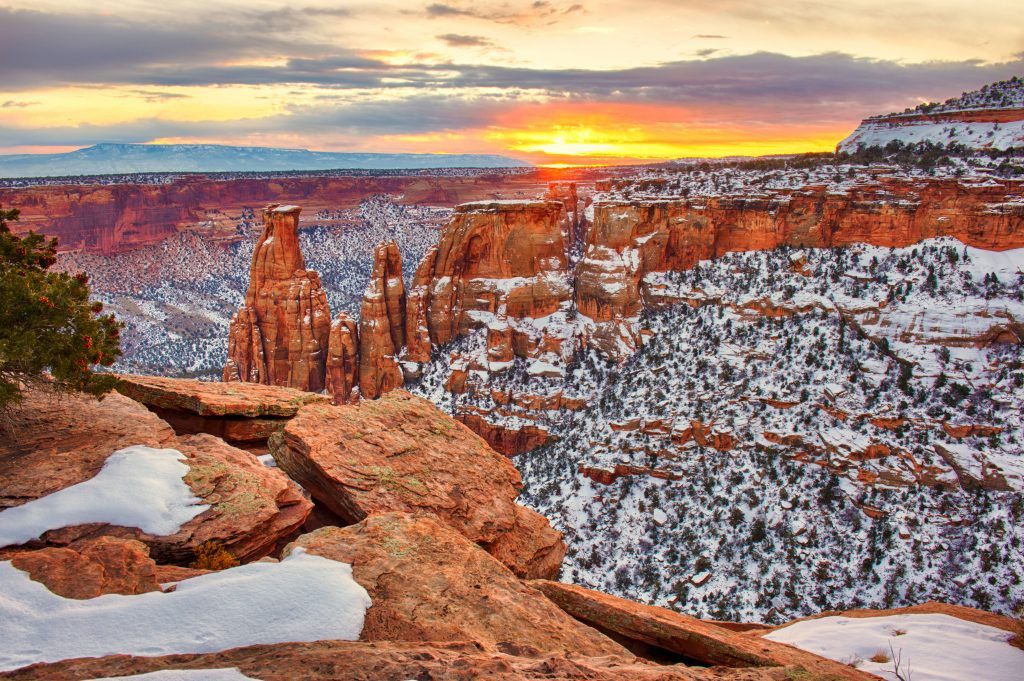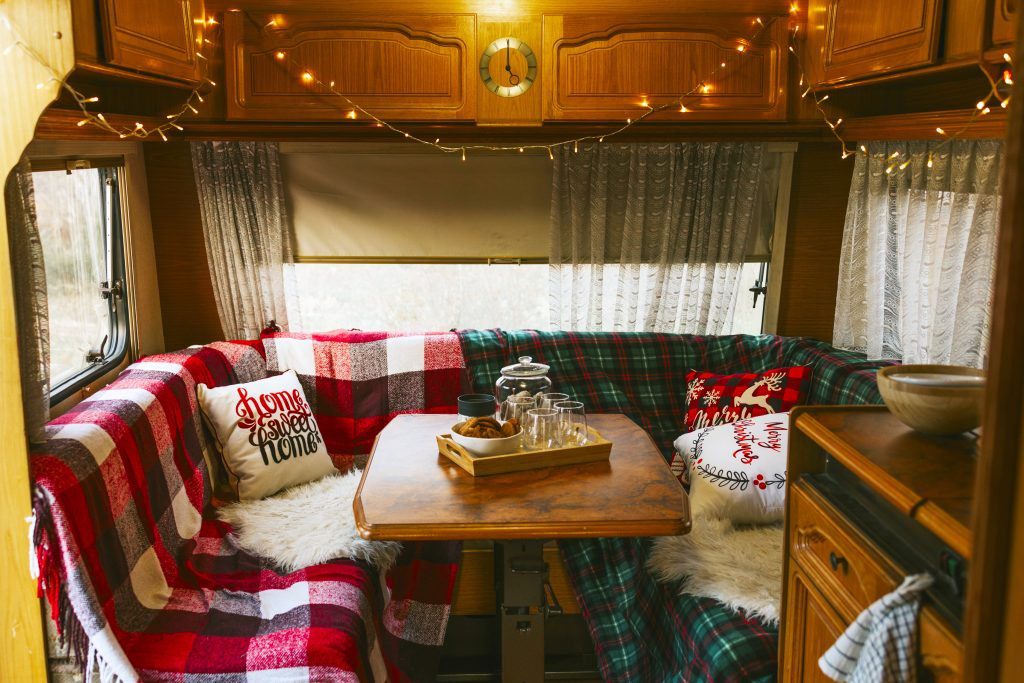RVnGO’s Guide to Winter RV Camping
Thinking of cold weather camping in an RV but you’re not sure where to start? RVnGO has you covered.
The winter months are some of the best times to camp for nature lovers. National Parks have far less people in them, and some places are best enjoyed in the snow. However, that doesn’t have to mean that your camping experience is a cold and uncomfortable one.
Below are our Top 10 Essential Items To Bring For Winter Camping, plus a checklist of things that you should do before you rent an RV in the winter.
Before you RV checklist:
Make sure your RV rental is properly winterized
Before you rent an RV, double check with its owner that the RV has been properly winterized recently. When you’re asking, make sure to clarify things like whether or not the RV comes with skirting or tire chains, or if it has vent covers for proper insulation. This way, there won’t be any unwanted surprises once you’re on the road.
For more information on how to properly winterize your RV, click here.
Bring RV antifreeze
Although this may be something that your RV host can provide you, it doesn’t hurt to bring your own supply of RV specific antifreeze. If you plan on using your RV’s bathroom or kitchen while you camp, run RV antifreeze through the pipes beforehand to keep them from expanding or bursting in cold weather. Make sure that the antifreeze that you buy is pink, for RVs.
You may also want to bring cold weather windshield wiper fluid as well, if the RV isn’t already fitted for it.
Make sure your destinations support electric hookups

Unless you’re planning on boondocking, or dry camping, you’ll want to be able to use your RV rental for all of its luxuries in the cold. Make sure that the RV campgrounds that you’ll be staying in support full electric hookups throughout the winter months— don’t take for granted that they will.
National Parks that support full electric hookups year round
Below are several National Parks in the US that are accommodating for winter RV camping throughout the year.
- Yosemite National Park in California
- Rocky Mountain National Park in Colorado
- Glacier National Park in Montana
- Great Smoky Mountains National Park
- Grand Canyon National Park in Arizona
- Mount Rainier National Park in Washington
Ten Essential Items To Bring For Winter RV Camping
Emergency GPS system
It goes without saying that for any remote camping expedition, an emergency GPS device of some kind should be kept on hand. In the case of winter RV camping, it’s of paramount importance to keep a GPS system securely stored in the RV. Devices range anywhere between $30-$500, and most are powered by USB charged lithium ion batteries for guaranteed long-lasting power.
Five gallons water + extra food
Just as importantly as the emergency GPS system, you should prepare your RV rental to hold at least five gallons of water. When it comes to how much food you should bring, there’s no exact answer. Depending on how many calories you consume on average daily, as well as how rigorous your camping activity will be throughout your stay, your amount of food per day will vary. However, as a rule of thumb if you plan on hiking throughout your trip, pack at least 2 lbs of food per person per day. This ensures that the body can consume recovery calories of up to 4,000 a day, with the rest left for emergencies.
Dehumidifier
If your RV rental comes with vent covers, this may not be needed— but it’s still good to have on hand, just in case.
Bringing a dehumidifier is vitally important to winter RV camping to keep the RV rental clean. When cooking and showering in an RV during cold weather, you’ll want to keep windows and doors sealed shut to prevent heat from escaping. However, if the unit isn’t being properly ventilated to account for this, mold and bacteria will invade its surfaces. Whenever you’re cooking in an RV without ventilation, run a dehumidifier during and afterwards.
Extra blankets and sleeping bags
Extra blankets are important for more than just keeping as warm as possible while you sleep. One way to keep an RV insulated against the cold is to lay rugs down on the floor; if you’re renting an RV in the winter, and you don’t have rugs to bring, thick blankets placed along the floor in key spots can help to keep the cold out. A good sleeping bag that’s designed for cold weather purposes is always recommended for extra warmth at night.
Layers of clothing for insulation + snowshoes
Like the layers of clothing that are needed for hiking in cold weather, relaxing in your RV should be comfortable but thoughtfully planned. Rather than a moisture wicking base layer as for hiking, your base layer in the RV should be a pair of long-johns for your legs. Up top, wear a long-sleeved undershirt that’s not too thick to be able to layer properly. Socks can be layered too, or worn in slippers. A middle layer of sweatpants and a flannel shirt keep things from being too congested indoors or while you’re sleeping. Then, if you’re still cold, a fleece or wool outer layer for your torso will help seal in body heat.
Make sure to set a designated area for wet clothing by the door, especially snowshoes and snowboots. Dirt or snow won’t be tracked onto any blankets or rugs on the ground, thus helping keep things warm.
Blow dryer
In the event that any pipes or hoses freeze while you’re camping, a blow dryer is great to keep on hand for defrosting purposes. And, although you may prefer to dry you hair naturally, most of our body heat actually leaks out from the head. To combat this, use a blow dryer after you shower to retain extra warmth.
Shovel
A shovel can not only be used for clearing pathways for your RV, but for keeping the RV warmer. If you don’t have skirting to put around the RV, a shovel will clear snow from beneath the vehicle. This way, your pipes will be kept from freezing. As a bonus, the cold from the snow won’t extend up into the RV. Shovels are always handy for digging out of jammed spots.
Portable space heater
Keep comfortable inside your RV rental without constantly reaching for the thermostat by using a space heater. Portable indoor space heaters come with auto-shut off modes in case of being tipped over. A standard heater covers up to 200 feet. Before you purchase, double check its safety features.
Heated mattress pad
If you’re unable/don’t want to get a portable heater, a heated mattress pad could be the way to go. Typically priced at less than between $40-$80, heated pads come with pre-heat and automatic turn off settings. A heated pad is also a good option for people that don’t like to sleep in as many layers.
Emergency survival kit
Although it’s a no-brainer, a good first aid kit for winter RV camping should have more than just the basics. Finding a set that doubles as an emergency survival kit is excellent for peace of mind. Good kits will include whistles and fire starters in addition to gauze pads and bandages. Taimasi’s camping first aid kit costs $40 and includes 152 pieces, including fishing hooks, work gloves, folding knives, and more. The kits are uber-condensed and easy to fit in your RV rental’s storage spaces.
When it comes to cold weather camping in an RV, you can never be too prepared! Stock up on the essentials and make sure that your RV rental has been properly winterized with your host before you go.
